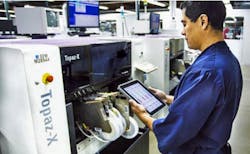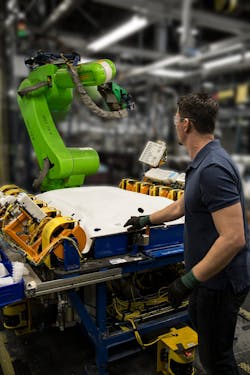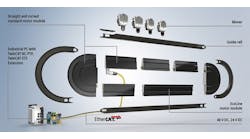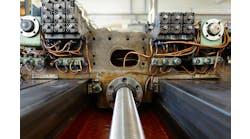Technology will leave you behind if you try to stop it. Will automation and robots replace personnel? What is the reality of automation's effect on jobs in the manufacturing industry, and how is machine control affecting it? A machine builder’s or system integrator’s or automation supplier’s opinion might vary from that of the masses.
Taxation, regulation and redistribution of profits from productivity gains are a few of the ideas designed to slow or discourage automation. But what is the net effect of increased automation on the economy and the people (Figure 1)?
Figure 1: Expanding the use of automation creates new or better jobs, not more regulations.
(Source: Fanuc)
The effects of automation
"Automation certainly reduced direct manufacturing jobs in the United States through increased efficiency and productivity on a per-employee basis," says David Paul, engineering design manager at Maverick Technologies, headquartered in Columbia, Illinois, and a member of the Control System Integrators Association (CSIA). "The United States manufactures more things than ever, but it takes far fewer people to create it, giving the impression manufacturing is in a decline in the United States. Automation has also changed the nature of manufacturing jobs, due to increased skill requirements to effectively utilize automated technology."
Many of the job losses in manufacturing due to efficiency gains have already occurred over the previous two decades, says Paul. "Many of today’s automation projects are migrations from obsolete, no-longer-supported automation platforms to current versions of the hardware," he says.
While the new hardware may produce incremental gains in control effectiveness, the real gains will come from the ease in which data can be extracted for analysis from the new hardware platforms. "The new automation and control hardware will support IIoT (Industrial Internet of Things) efforts for large-scale data collection and analysis," says Paul. "The ability to easily collect, store and analyze large amounts of data from the control system is a recent development, but the ability to leverage this data for quality and productivity improvements is an effort that early adopters are just now implementing. This is an area where the next tier of gains in manufacturing will be made."
Many manufacturing jobs have already been replaced by robots, and more will be replaced in the future, says Doug Putnam-Pite, director of software development at Owens Design in Fremont, California. "While the repetitive and dangerous jobs are being replaced by robots, the irony is that these same factories will now need highly trained technicians and possibly engineers to service and maintain these new robots and automation."
If one takes a look at the history of the semiconductor industry you will see what is in the future for other manufacturing industries, continues Putnam-Pite. "Several decades ago, the semiconductor wafer fabs were run by PhD scientists and technicians. Now the modern wafer fab has more IT personnel than scientists and technicians. The fabs have become highly automated and connected, requiring vast numbers of highly skilled IT personnel."
The market decides
Who's applying for the job and are these resources available? "I try to look at the solution to a problem through the sensors of the control," says Gary H. Lucas, director of innovation at Innovative Treatment Products in Owings Mills, Maryland. "Put yourself in a room with no windows and only the inputs of the sensors available to you on a screen. Can you do the task with just that information? A simple task performed by a human using just one hand, without seeing, may be impossible to complete. AI will certainly help, but without any data it might do what humans do, which is guess.”
Aging demographics and a persistent skills gap will drive automation, not to eliminate jobs, but to automate the job openings that can’t be filled, says John Kowal, director, business development at B&R Industrial Automation. "This should actually be the question—what will drive the next level of automation? Culturally, it will be the need to serve an aging or, in many countries outside the United States, a shrinking population," he says.
More automation is needed. "The pace of industrial change is slow in the United States because the bottom line drives business, and manufacturing is considered an overhead cost, not a core competitive advantage," says Kowal. "Automation will become core when products can’t be produced without a substantial reinvestment in manufacturing, when cheap offshore labor doesn’t exist any more. And that time is coming sooner rather than later."
Automation as the good guy
"Technology is always on the move, and advances in machines and robotics have made them an integral part of today’s world," says Bill Dehner, technical marketing engineer at AutomationDirect. "From automated manufacturing to self-driving cars and vacuum cleaners, robots and machines have infiltrated and will continue to infiltrate our everyday lives. Although some have tried to label automation as the newest bogeyman on the block, as it is often the primary scapegoat for high unemployment numbers or lost jobs, automation is nothing to fear."
The United States is mobilizing future workers. "With many schools focusing on STEM (science, technology, engineering and mathematics) curriculums, the future of automation holds a lot of exciting opportunities and career possibilities," says Dehner. "Just think, 15 years ago, being a mobile app developer was unheard of, but, just as with smartphone technology, when any technology advances, so does the need for designers, engineers, builders and maintainers. So automation should not be considered a job stealer but more of a job shifter—taking the future workforce to a more technical and higher-paying position (Figure 2)."
Figure 2: Automation is taking the future workforce to a more technical and higher-paying position.
(Source: AutomationDirect)
Technology advances increase opportunity, says Chris Como, portfolio manager, motion control business, Rockwell Automation. "Automation can help humans to broaden their existing tasks and even open the door to new roles," he says. "I believe the increase in robots in the manufacturing industry will actually add jobs and, in many cases, add better jobs. It should be viewed as a very exciting time for industry and the workforce, especially younger, technology-driven workers."
Changing job titles
Some jobs will go away due to automation. "Yes, automation in general replaces some manual functions across many sectors, including manufacturing and service industries," says Aurelio Banda, president and CEO at Beckhoff Automation. "This has been happening since the first industrial revolution with the beginning of mechanization. It is the responsibility of employers to make meaningful investments to upscale skills of the current workforce in an ongoing mission to create better jobs today and tomorrow. When examining automation and jobs, it is rarely a linear effect. I see it as a blend of changes that are equally affected by other areas—such as business management practices and hardened philosophies—that occur slowly over time."
Fortunately, automation- and technology-related jobs are better. "Technology advances in general are also proven to generate new jobs and professions that didn’t exist before," says Banda. "They may also preserve jobs that we may never know would have been lost otherwise. Automation and strategies such as Industry 4.0 can prevent job losses in industrialized countries by keeping plants open or by breaking ground on new ones that would have been offshored to lower-cost countries just a few years ago."
Automation has and will continue to increase the quality of life for consumers across the globe, explains Banda. "This means many more people today have improved access to products and services that were previously unaffordable," he says. "For many, this translates to more abundant food and products of all kinds that are safer to use. Especially for industrialized countries, this means lower-cost goods that are available in greater variety, and with dramatically increased options for customization."
One of the common counterpoints to the idea that automation and robots will replace humans is, while some lower-skilled jobs may indeed be eliminated, others will remain intact but change in nature, says Arun K. Sinha, engineer with Opto 22. "There may be a requirement for new skills, and it is incumbent on employers to retrain workers, and individuals must take steps to learn new technical skills," he says. "For example, when automation or a robot could replace a manual or repetitive operation, that could create a need for someone with domain expertise on the machine, line or process to analyze new data available as a result from this change (Figure 3)."
Figure 3: As automation, machine controls and robots become smarter, they often become complements to humans, rather than substitutes.
(Source: Opto 22)
The reality is, as automation, machine controls and robots become smarter, they often become complements to humans rather than substitutes. "Artificial intelligence is in the early stages and progressing rapidly, but there will always be certain types of decision making uniquely suited to humans," says Sinha.
Transforming the work environment
"We are not just suppliers of automation technologies; we are also users, with hundreds of IoT-equipped manufacturing systems in our plants worldwide," says Allen Tubbs, product manager, IoT, at Bosch Rexroth, a member of CSIA. "Automation is used to take over work that is unsafe or highly repetitive, so that our associates can be given more meaningful work. Even in manual or semi-automated manufacturing environments, automation can help, with process-assistance technologies. The ability to stream data via machine controls makes much of this possible and gives plant-floor personnel a much-improved working environment."
Always look for opportunities to automate. "There are jobs that have some elements of danger to them, and robotics can help to minimize danger to humans, but they also can become assistants to collaborate and help improve productivity within an operation," says Bob White, training and digital services manager at Kollmorgen. "This does not necessarily displace the workforce, but it transforms the workforce."
Improving the process through automation does change things. "Advanced automation approaches are reducing waste—raw material efficiency, scrap and rework—as well as emissions and safety issues," says Sanket Amberkar, senior vice president of marketing at Falkonry. "It is clear there will be an increase in the number of jobs that can apply analytics and automation control in more industries, but there may be a reduction in the scheduling and total amount of labor required for maintenance. However, given an aging workforce, there are fewer of these employees due to the number of people retiring. The job-creation rate will probably be close to the job-loss rate, but it’s different jobs and people.”
Better machine control
"Automation in manufacturing is not replacing personnel, but rather allowing companies to better deploy their personnel to improve efficiency and productivity and ultimately grow in revenue and profit," says Geoff Dawson, director of sales, Michigan region, at Fanuc (www.fanucamerica.com). "Industrial robots are being applied into the dull, dirty and dangerous jobs. In modern manufacturing, people are now being trained and reassigned to manage the automation, as opposed to performing all of the processes manually. In many cases, a single operator or team of operators can be responsible for running multiple processes" (Figure 4).
Figure 4: People are being trained and reassigned to manage the automation, as opposed to performing all of the processes manually.
(Source: Fanuc)
Machine control becomes an important part of this new approach to manufacturing. "The manufacturer now has a window into the process and can understand where issues are and the knowledge to apply countermeasures," says Dawson. "This responsibility can be passed to the operator who is now managing the manufacturing cell. We can say that the employees are being used smarter and not harder, or, as Missy Rogers of Noble Plastics said, ‘exploit the equipment and not the people.’ New employees in the workforce have been brought up on electronic technology, such as tablets, smartphones, PCs and video games, so exploiting their knowledge and ability to use technologies can be the backbone of a strong machine control strategy."
Omron Founder Kazuma Tateisi once suggested giving the work to the machine and the thrill of creation to the people. "If a job is completely repetitive task-oriented, then there is a chance that technology, including robots, can be programmed to do those tasks more consistently and efficiently than humans," says Mike Chen, director—Automation Center Americas, Omron Automation Americas. "The reality is that employers will need to change jobs to be more than tasks and leverage human innovation. Another less-famous saying is that the human being is still the cheapest 150-lb all-purpose reprogrammable supercomputer available. High variability and any need for creativity or human service is still firmly the strength of people over technology."










